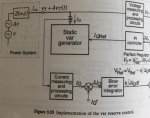Please don't confuse real power (W) with apparent power (VA)
They are not equivalent.
Now, can we get back to the OP's question?
'active' power, real would imply imaginary power, trust me it's real (reactive) lol
no one is misunderstanding the concept except you
nope, you claim power is only watts, it is actually va
watt = J/sec = C V / sec = VA
s is in va, so the units of sqrt (P^2 + Q^2) must also be
a va ~ w, we call them different things for clarity of convention, not because they are different, all are v x a
now, what assumptions need made to answer the op's question?


